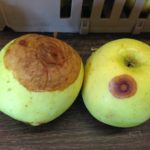If you sold, or normally do you sell, more than $1000 worth of agricultural products in a year then it is your responsibility to fill out the 2017 USDA Census of Agriculture. USDA’s National Agricultural Statistics Service (NASS) needs a Census of Agriculture response from ALL the nation’s producers. In order to get an accurate[Read More…]
Crop Management
The proper time to remove straw from matted row strawberries is when the bare-soil temperature at 4 inches averages about 40-43˚F. This usually coincides with mid to late March in central Indiana. This year is later than average with soil temperatures still in the 40s. Plants will begin pushing new leaves as the soil temperatures[Read More…]
It’s been a cool spring this year and brambles are still mostly dormant in the Lafayette area. This is a good time to finish pruning chores. In summer fruiting types, this past year’s fruited canes should be removed if they were not removed last summer or fall. Remove weak or spindly floricanes and thin to[Read More…]
Check list: ~Indiana Disease management program for apples for 2018 is available at: https://www.extension.purdue.edu/extmedia/BP/BP-201-W.pdf This information is identical to the Midwest fruit pest management guide, but provided in a table format and includes Fungicide Resistance Action Committee (FRAC) Codes, REI, PHI and efficacy information for each product (Fig. 1). ~Reducing overwintering inoculum for apple scab:[Read More…]
Spring freeze damage can be a significant economic problem for Midwest grape growers. Widespread damage occurred in 2007, 2012 and 2017 when warm temperatures in February and March were followed by freezing temperatures. Obviously this year has been very cool so far so there is hopefully less risk of early budbreak and frost damage. But,[Read More…]
This winter was significantly colder than normal in the northern half of Indiana. Many areas north of “I-70” experienced temperatures between -15 and -20˚F in early January. That is cold enough to cause considerable cold injury to grapes, peaches, and blackberries. See the map below for minimum winter temperatures. We have evaluated crops at the[Read More…]
Summer rots continue to rear their ugly heads (Fig. 1). This year, we are even seeing them on late season apples like Evercrisp (Fig 2) and GoldRush. On the plus side, we are seeing some level of control with all fungicides in our trials (data will be presented at the Indiana Hort Congress); unfortunately,[Read More…]
Fruit rots continue to pose a problem for those of us in the wetter parts of the state. Frequent rains and warm temperatures really set the stage for bitter rot, black rot, white rot, and even brown rot. Any rain event that produced more than 2” of rain would remove the majority of fungicide, meaning[Read More…]
Grape harvest is in full swing across the state. The weather could not be more ideal. Warm sunny days and cool nights are ideal for fruit quality. Lack of major rainstorms is also a plus. This year is almost a complete opposite of 2016, when high temperatures and rain persisted through July and August, causing[Read More…]


